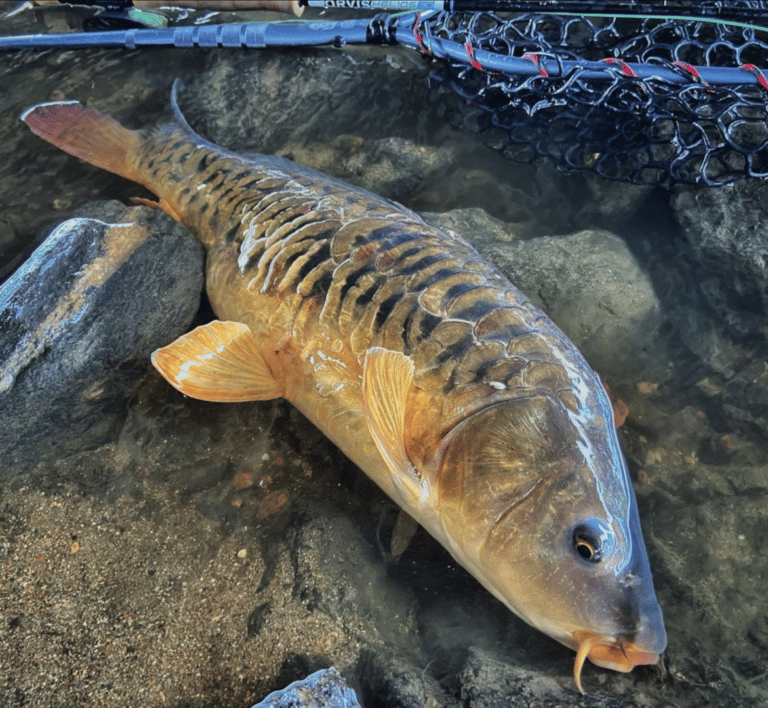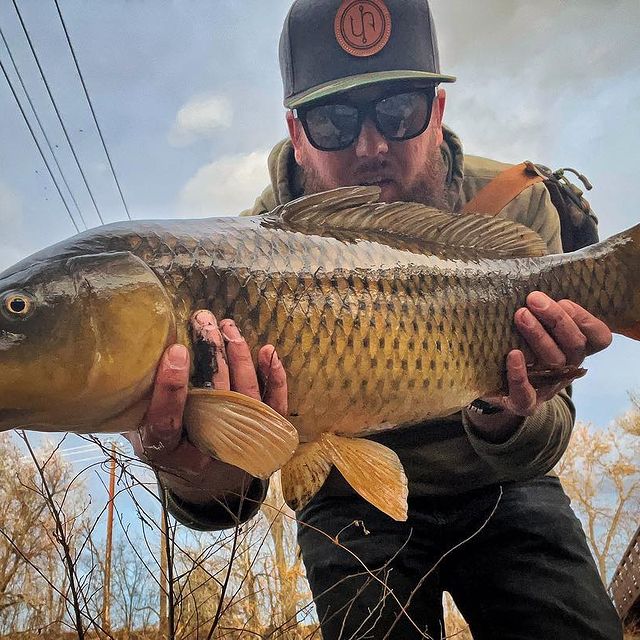Blog Carp Education Rick Mikesell Warm Water Fishing
October 16, 2022
By: Rick Mikesell
Rick lives in Denver, Colorado and is the general manager for Trouts Fly Fishing in Denver. He has been fly fishing for 25 years and has been obsessed with carp fishing for 20 years. He fishes, teaches and guides on the Denver South Platte River, an urban river that was neglected and polluted in the 50’s, 60’s and 70’s. It rebounded as people became more aware of the importance of urban fisheries.
Today he is presenting carp fishing tips and techniques.
the common carp
Carp were introduced in the US as a food and sport fish and on the the South Platte River in Denver in 1874. For a long time, carp were thought of as an invasive species, a trash fish. If you travel to Europe, they’re more popular than trout or bass. Carp are large, abundant and hard to fool with a fly.
- Found in every state except Alaska
- IFGA all tackle record- 76 lbs
- Active in a wide temperature range
- Voracious omnivore
- Can spawn multiple times a year
- Exceptionally hardy- can tolerate low oxygen
- Well developed hearing- weberian orgen
- Sensitive lateral line and barbels
- Highly developed olfactory system
- Color vision
- Excellent close up/poor at distance
- Wide angle monocular vision
- Rear blind spot
- Poor focus but excellent movement detection
Necessary Equipment
- Fast action 9 ft 6 or 7 wt fly rod
- Large arbor reel with good amount of backing
- Appropriate weight forward floating fly line of muted color and taper
- 12-16 lb fluorocarbon leader
- 7-8 ft for tailing presentation
- 10-12 ft for clooping presentation
- 12-16 lb fluorocarbon tippet- sinks faster
- Polarized sunglasses- copper or amber; need to be able to see the fish
- Large landing net
- Flies
- Leader to tipper- blood knot
- To fly: loop knot- allows more action; clinch knot on jig flies
Seasons of carp
- Can fish 365 days a year, with appropriate ambient temps
- Spring, summer and fall are continually consistent, with appropriate ambient temps
- Look for shade on hot days
- Calm days ideal
- Sight fishing- can see the fish better on calm days
- Approaching fronts stimulate feeding- high clouds, rain, socked in weather are the best catching days
- Low light
- Harder to see fish, harder for them to see you
- Night fishing possible- if you can see them!
- Winter carping
- Warm days, warmest part of the day
- Rip rap radiates heat
- Slow metabolism
Identifying happy fish is the key to success
- Actively feeding- mouth opening and closing
- Moving but not as defense
- Three types of happy fish
- Tailing fish
- Face down/tail up
- Mudding
- Tail or back out of the water
- Mouth sifting for food sources
- Highest chance for success
- Clooping fish
- Slurping in surface film
- Moving with purpose
- Food source trapped in surface film
- Cottonwoods, Mulberrys, midge larvae
- Can be a tougher target
- Cruising fish
- Moving with purpose, not out of alarm
- Stopping to eat in mid water column
- Best example is dragonfly larvae eaters in heavy weed growth
- Tailing fish
- Avoid fleeing/spooking fish
- Avoid stagnant/sunning/overly cold fish
Forage and flies
- What to consider when choosing fly color and pattern
- Weight, confidence and hook are the more important than pattern
- Weight is most important- need to get fly down to where fish is feeding quickly
- Headstand style
- Crayfish- most common
- Dragon fly nymphs
- Higher water temps
- Heavy weed growth
- Adult dragonflies visible
- Worms
- Primarily used in moving water
- Effective in winter or on heavy flow, high color days
- For clooping fish
- Cottonwood seeds and mulberries
- Chironomid nymphs
- Soft hackle wet flies
- Eggs
- Indicator fishing
- Least effective way to catch carp
- Energy consumed vs energy expended
- Carp will not move more than 6-8″ to the fly
- Carp are not likely to chase down a nymph in moving current
- Prey never swims toward a predator

Presentation
- Most important part of carp fishing!
- Make it look like the food it’s mimicking
- The biggest challenge- getting the fly into the zone without spooking the fish
- Use high vantage points
- Avoid loud colored clothing
- Stalk and drop- the closer you can get to the fish, the better you can present
- Drag and drop casting
- Cast 2-3 feet past the fish- ideally in the blind spot towards the tail
- Lift fly up into the surface film
- Use rod tip to drag fly directly above feeding zone
- Gently drop fly into feeding zone
- Subtle fleeing action
- Match prey’s movement
- Slower than you would expect
- Leave it in the zone
- Subtle twitches, not long strips
- Match prey’s movement
- Prey never swims toward a predator
- If the fish does not move to the fly, pick it up and put it right back in the zone
After the eat
- Eats are very difficult to feel
- Easiest way to tell- watch the mouth drop over the fly
- Fish will immediately know it’s not real and pull back
- Set as soon as the mouth is completely over the the fly
- Murky water eats
- Happy tails
- A distinct wag of tail when fish moves to fly and stops
- Sets are free
- Keep a very tight line to detect the most subtle of tension changes
- Happy tails
- Hooksets are determined by your location in relation to the fish
- Close shots are usually best served by “trout” sets
- Always strip set at distance
- If you miss the eat, there is always potential for another with the strip set
- Line maintenance is critical
- Make sure all line is snag free and ready to clear the guides
- Don’t baby the fight
- If using heavy fluoro (8-12 lb) a fair hooked fish will rarely break off
- Make sure your flies are tied on quality hooks
- Practice your knots
- Use low rod angles to put pressure on the fight
- Once they start gulping on the surface, they’re usually ready to be landed
- Safe handling of the fish
- Use a large bag net so as not to damage fins
- Carp are much hardier than trout but still take care to get them back in the water as quickly as possible
- In high or low temperature conditions, take the time to revive fish, if necessary, for a strong release



